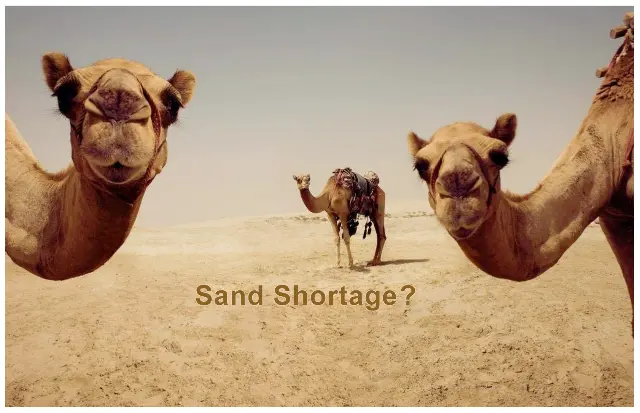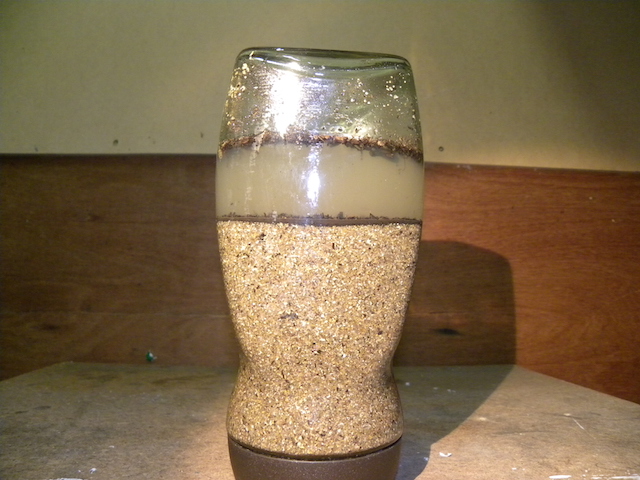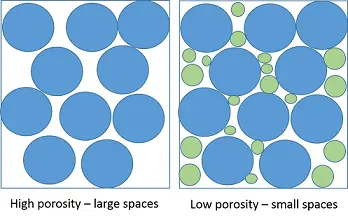Sand
No Sand – No Civilization
Sand is a benign substance that resides in the back of our minds. For most of us, it holds no more day-to-day interest than the rocks and roads – and the other physical aspects of our environment. We know that it exists, but it hardly warrants a thought.
But, as Vince Beiser reminds us in his book – “The World in a Grain” – there is no civilization without sand.
(If you have a spare hour to burn in the quest for sand knowledge, here’s a video in which Vince Beiser explains why that’s the case.)
Of all the things that we can do with sand, none is more worthy than to grow food with it. And of all the ways we can grow food, nowhere will we find a better media in which to grow it.
With that, it’s time to learn more about the most cost-effective growing media available – anywhere – so let’s begin with…
What is Sand?
Back in ‘Horticulture’s Best Kept Secret’, we discovered that sand:
- Is a particle size as much as a substance
- usually comprises mineral and rock particles
- ranges in size from 0.06 mm to 2 mm (0.002–0.08 inches)
- is finer than gravel and coarser than silt/dust.
Sand is the most commonly available substance on the surface of the planet…and silica quartz sand is the most commonly available sand. And that’s the sand we want for use in iAVs.
Why Sand?
Sand is far more available than any soil type – much less good organic soil.
Sand can be managed to provide the ideal plant-growing environment…both physical and microbiological.
You can systematize your food production when you use sand – providing the ideal mix of drainage and water retention – and intermittent irrigation – so that your plants have all the water and nutrients that they need – on time!
Sand is the most cost-effective filtration method ever…available since before recorded history…and used to capture the solid wastes from the fish and convert them to plant-available nutrients.
Sand is 100% recyclable…it can be washed and sieved and re-used…forever!
Sand can be stored…dry and pest-free…and get bio-activated quickly and as required.
When you use sand, your garden grows both biologically – and financially.
Washed and graded sand is a permanent asset that does not require replacement – and only very modest maintenance. Given the global demand for sand (upon which our lives depend so much), the price of sand can only continue to rise.
Sand + organics + oxygen + water + microbes + light = SOIL
Unfortunately, not all sand is suitable for iAVs.
iAVs-Suitable Sand
Sand that is to be used for sandgardening should be:
- Inert
- Free of silt and clay
- Able to drain effectively
When we speak of ‘inert’ we mean that the sand should not produce a chemical reaction when in contact with water. Sand that contains carbonates, for example, will create issues with the pH of the water in the system…leading to nutrient deficiencies.
The sand that best satisfies these criteria is crystalline (sharp) quartz – Silicon dioxide – known more commonly as silica sand.
Granite – and rounded sand – will work, too.
Sandstone and beach sand will usually contain substances that make them less suitable for sandgardening purposes. Similarly, flat and flaky sand is to be avoided.
Sand that contains silt and clay may harbor harmful pathogens or pollutants and will impede drainage.
Sand Particle Size Range
Sand that is not of the correct particle size range will also present drainage problems.
As we learned earlier, sand ranges in size from 0.02 mm to 2 mm (0.0008–0.08 inches). The ideal sand will comprise the following particle sizes:
- 40% by volume in the size range between 1 and 2 mm.
- 40% by volume in the size range of 0.5 to 1 mm
- 20% by volume in the size range of 0.25 to 0.5 mm
- A small amount larger than 2 mm is okay, but virtually nothing less than 0.25 mm is recommended.
Rarely, if ever, will you encounter a sand vendor who actually knows the particle sizes of their sand mixes, so the only worthwhile use for the above information is to impress on you that the range provides optimal drainage – neither too slow nor too fast.
If the sand drains too slowly, it will not allow sufficient time for the bed to empty properly. For reasons that we’ll explain later, sand beds must drain completely – and too great a proportion of fine particles will inhibit this.
Sand that contains too much fine material is not suitable.
If the range comprises too great a proportion of coarse material, it will drain far too quickly – and that’s a problem because:
- There may be insufficient time to saturate the sand beds.
- The sand will not retain sufficient moisture between irrigation events – resulting in stressed plants.
- It will reduce the effectiveness of the sand bed as a biofilter…limiting the number and variety of soil microbes…and negatively impacting the rhizosphere.
- Organic matter will penetrate the lower sections of the sand bed instead of being trapped on the surface.
If you had to make a choice between having sand that is too fine – and that which is too coarse – it’s better to go for the coarse option because you can add other particle sizes to the existing sand to slow the drainage rate to something more suitable. The best option, of course, is to get it right the first time.
Sand Availability
From time to time, we hear people say that silica quartz sand is not available in their area.
I can’t remember when we failed to locate a source of sand – or that it took much longer than 15 minutes of googling to find it. Anywhere!
And while it’s invariably deeply satisfying for the person for whom we’ve done this little trick, we are no longer available for the task.
People also periodically say that sand is available, but it’s far too expensive. That’s a different story – and a highly subjective one.
Sand Cost
The two factors that most influence the cost of sand are its purity (absence of silt, clay, and other contaminants) – and how far it must travel from its source.
At the top end of the purity and price spectrum is filter sand. It will be free of silt and clay and of a predetermined sand particle size range. It will come in bags for ease of handling.
This is likely the most convenient – and most expensive – way for us to acquire sand.
At the other end of the sand spectrum, we have the stuff that’s straight out of the river, quarry or sandpit.
This is likely to be the cheapest option because it hasn’t been cleaned or separated into the particle size range that we’re seeking.
The viability of general-purpose sand really comes down to luck – and how ‘hands on’ you wish to become in obtaining your sandgardening media.
We can screen or separate the particle sizes…and wash the silt and clay out of it…but, even assuming we’ve got enough of the right material left to justify the cost of the raw material (and its transport), we’re going to be up for a lot of hard work.
The Happy Medium – or Media
Somewhere in between the costly filtration product…and the run-of-the-mill general purpose stuff…is bulk sand that has been washed and graded for specific purposes – like construction, top dressing of golf courses and artificial wetlands.
This sand may not be quite as clean as filter sand…and it might not have the same precise particle size range…but it will be much less expensive – often being only marginally more costly than general-purpose sand.
Where to Obtain Bulk Sand
Our preferred sources of sand include:
- Quarries – where they manufacture sand.
- Specialist sand vendors – Google is your friend (so we’re told).
- Cement or cinder block makers – ask them to tell you where they buy their sand.
- Retail landscape suppliers.
Sand Sources to Avoid
The places we don’t recommend include beaches – because the sand almost always contains calcium carbonate – and that will, upon contact with water, produce high pH levels…about which we’ll say more later.
The other places to avoid are riverbanks in urban areas – where the sand is frequently full of pollutants…including pharmaceuticals, chemicals, heavy metals, sewage, and even nuclear waste…and in industrial farming regions where the issue will be synthetic herbicides and pesticides – and chemical fertilizers – and manure. Lots of manure!.
We always need to remember that our sandgarden is about producing clean fresh food and that should drive what we put into the system.
So, if you suspect that a sand sample contains potentially harmful contaminants, get a materials testing laboratory to confirm that it is OK before you use it.
Not all sand vendors are equal in terms of the purity and grading of their product, so unless you’re buying sand that is certified as to its content and particle size range (like filter sand), your only option is to test it.
A square meter of iAVs growing space – at the recommended depth of 350 mm – will contain over 300 liters of sand – weighing upwards of 450 kg.
So, it’s something we need to get right – the first time. Fortunately, that won’t be difficult if we test the sand before committing to large quantities.
The other thing is that you only need to source the sand for a particular sandgarden once. In human timeframes, sand lasts forever.
Testing sand – for our purposes – is simple and costs next to nothing – and we’ll show you how to do it right now!
Testing Sand
Confirming that a particular sample of sand is suitable for use in an iAVs, is quick and easy and involves a series of simple field tests:
- Carbonate
- Turbidity
- Differential Settling
- Pore Space Volume
- Hydraulic Conductivity
- Water Retention
- pH
To do these tests, you’ll need:
- A couple of 1-liter measuring jugs.
- A clear bottle or a jar with a lid.
- A freshwater pH test kit that measures 4.0 – 9.0
- Vinegar.
- Water
- Pen and paper – to record the results.
- A simple percolation tester – that we’ll show you how to make for pennies.
- A bucket.
….and let’s not forget…..some sand.
Vinegar Test
When we talk about the need for the sand to be inert, we mean that it is not chemically reactive. That is, the pH of water should not change when it comes into contact with the sand.
Why is pH important?
The pH of water in an iAVs impacts the availability of nutrients. Operating in the range of 6.4 (plus or minus 0.4) ensures that the full spectrum of essential nutrients is available to the plants.
Conversely, the presence of substances in the sand that elevate the pH of the water above the optimum range will mean that certain nutrients are unavailable to the plants.
The most likely influence on the pH of water that comes into contact with sand is that of carbonates.
Sand that contains carbonates is not inert.
Interestingly, the presence of carbonates can be most easily established with plain vinegar.
To conduct the vinegar test, place some sand in the jar lid – and pour some vinegar on it.
To show you how sand containing carbonates behaves, in the presence of vinegar, we collected a sample from a local beach.
The vigorous bubbling evident in this sand tells us that it contains carbonate – is not inert – and is not, therefore, suitable for use in iAVs.
Turbidity
Turbidity is cloudiness in the water that would indicate the presence of large numbers of individual silt or clay particles that would otherwise be invisible to the naked eye.
The turbidity test is also easy and requires nothing more than a glass jar or drink bottle with a lid.
Half-fill the jar with sand and then top it up with water.
Shake vigorously for 5 – 10 seconds and then place the jar on a bench to allow the contents to settle.

Differential Settling
Our next test – to establish the proportionate volume of silt or clay in our sample – is the easiest test of all. Simply leave the jar and its contents undisturbed for several hours.
Through a process known as differential settling, we can determine the proportionate fractions of silt or clay in the sand.
Once the sand has settled, any silt will show as a dark line on top of the sand….as evidenced in the photo below.
Clay, which has the smallest particles, will show as a pale layer above the silt…when it eventually settles.

Having confirmed that our sand is relatively free of silt and clay, our focus shifts to particle size and pore space volume…or porosity.
Pore Space Volume
The pore space volume refers to the amount of space (for water or air) that exists between the sand particles.
To measure the pore space volume, take one of the one-liter graduated jugs and place a liter of sand into it. Fill the second measuring jug with one liter of water.
Then, using the measuring jug, add water to the sand – noting the amount of water that you are adding – until the sand is saturated – or the water is just level with the surface of the sand.
Dry sand of the correct particle size range will have a pore space volume of around 25% – 30%.
If the pore space volume was much lower, that would indicate that the sand contained fine particles – and, depending on their volume, that might restrict drainage.
A higher pore space volume reading indicates that the sample contains coarse material – and depending on its volume, that may allow for the water to drain too quickly.
Another value of the pore space volume test, however, is to demonstrate that sand is not a solid – and that it has space for water, oxygen and the microbial life that powers iAVs.
Another thing to note is that sand will continue to settle the first few times that it is flooded and drained. Pore space volume will diminish initially and then stabilize. The importance of this is that, if your pore space volume is marginal at the outset, drainage could be negatively impacted in future flood and drain events.
Hydraulic Conductivity
The flood and drain cycle is important to iAVs because it provides the moist environment required by the plants and the microbial life that underpins iAVs. The drain cycle is equally important because it drives the gaseous exchange – the charge of oxygen-rich air that is also needed by plants and microbes.
Hydraulic conductivity is a term used to describe the ease with which a fluid – in our case, water – can move through pore spaces in various media. Of course, when we speak about media – in an iAVs context – we’re talking about sand.
The measurement of hydraulic conductivity – also known as the percolation rate – simply confirms the accuracy of the pore volume space.
Measuring hydraulic conductivity requires the use of a DIY device called a percolation rate tester.
Water Retention
Water retention refers to the amount of water that remains in the sand after the sand bed has drained.
Dry sand might have the appearance of a solid mass but, as we observed during the pore space test, it’s actually about 25% – 30% – by volume – of air.
It’s also important to understand that a quantity of water will remain in the sand following the drain cycle – and it remains there (available to the plants) until the next flood cycle.
The water that remains is bound to the surface of the sand particles by hydrostatic tension. We’re guessing that amount would be about 5% of the pore space volume – depending on the particle size and shape.
Note: It will be necessary to top up the fish tank after the sand beds have been flooded for the first time.
After the first flood and drain cycle, the exact amount of water retained in the sand will vary according to the elapsed time from the last flood cycle.
For example, about 5% of the water that was pumped may be retained after the first flood cycle in the morning – after a break of 8 hours or more – whereas only 1% will be retained immediately after subsequent flood cycles through the day (approximately two hours apart).
Note: These numbers are not prescriptive – they may vary from situation to situation, We use them to illustrate the dynamic nature of the relationship between sand and water in the system.
To establish the water retention of a sand sample, repeat the hydraulic conductivity test several times….measuring the amount of water that drains from the sand after each flood cycle.
pH
You complete the assessment or your sand sample with a pH test, and we’ll learn how to do that in the next section on “Water”.
Reconciling the need for iAVs-suitable sand with your budget may be tricky, but there are opportunities for those who want to make the effort. With that, we conclude this section on sand.
Key Points
- No Sand – No Civilization!
- Of all of sand’s uses, none is more worthy than using it to grow food.
- Sand is an appreciating asset.
- There is no more cost-effective media anywhere.
- The only certain way to know if a sand sample is suitable for iAVs is to test it.
- Sand comes with a lifetime warranty.
- The further you transport and process sand, the more expensive it becomes.
-o0o-







Responses